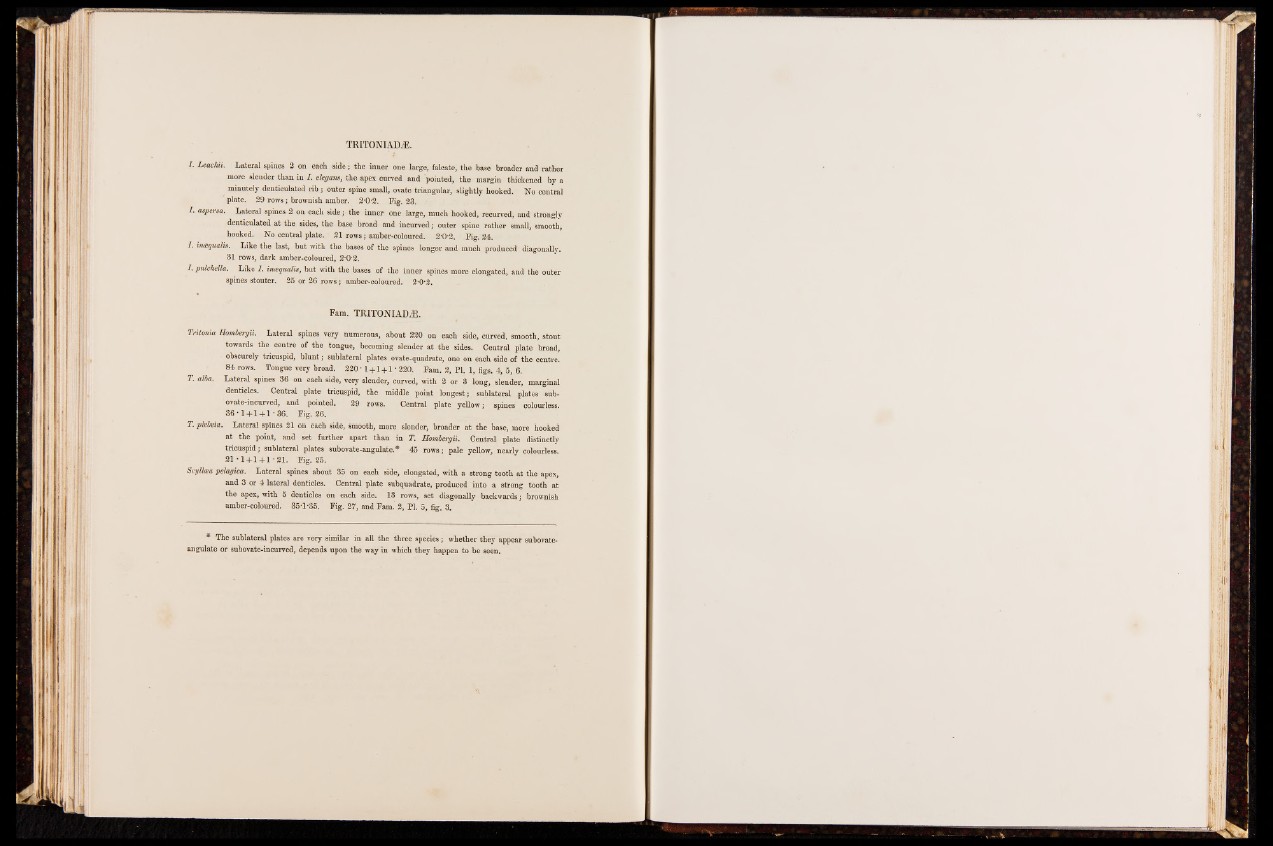
TRITONIADiE.
I. Lcachii. Lateral spines 2 on each side j the inner one large, falcate, the base broader and rather
more slender than in I. elegans, the apex curved and pointed, the margin thickened by a
minutely denticulated rib ; outer spine small, ovate triangular, slightly hooked. No central
plate. 29 rows; brownish amber. 2*0*2. Fig. 23.
ƒ. aspersa. Lateral spines 2 on each side; the inner one large, much hooked, recurved, and strongly
denticulated at the sides, the base broad and incurved; outer spine rather small, smooth,
hooked. No central plate. 21 rows; amber-coloured. 2*0*2. Fig. 24.
ƒ. inaqualis. Like the last, but with the bases of the spines longer and much produced diagonally.
31 rows, dark amber-coloured, 2*0*2.
I. pulchella. Like I. iruequalis, but with the bases of the inner spines more elongated, and the outer
spines stouter. 25 or 26 rows; amber-coloured. 2*0*2.
Fam. TRITONIADiE.
Tntonia Hombergii. Lateral spines very numerous, about 220 on each side, curved, smooth, stout
towards the centre of the tongue, becoming slender at the sides. Central plate broad,
obscurely tricuspid, blunt; sublateral plates ovate-quadrate, one on each side of the centre.
84 rows. Tongue very broad. 220 • 1 + 1 + 1 • 220. Fam. 2, PI. 1, figs. 4 5, 6.
T- alba- Lateral spines 36 on each side, very slender, curved, with 2 or 3 long, slender, marginal
denticles. Central plate tricuspid, the middle point longest; sublateral plates sub-
ovate-incurved, and pointed. 29 rows. Central plate yellow; spines colourless.
36*1 + 1 + 1*36. Fig. 26.
T. plebeia. Lateral spines 21 on each side, smooth, more slender, broader at the base, more hooked
at the point, and set further apart than in T. Hombergii. Central plate distinctly
tricuspid; sublateral plates subovate-angulate.* 45 rows; pale yellow, nearly colourless.
2 1 -1 + 1 + 1*21. Fig. 25.
Scyllaa pelagica. Lateral spines about 35 on each side, elongated, with a strong tooth at the apex,
and 3 or 4 lateral denticles. Central plate subquadrate, produced into a strong tooth at
the apex, with 5 denticles on each side. 13 rows, set diagonally backwards; brownish
amber-coloured. 35*1*35. Fig. 27, and Fam. 2, PI. 5, fig. 3.
* The sublateral plates are very similar in all the three species; whether they appear subovate-
angulate or subovate-incurved, depends upon the way in which they happen to be seen.